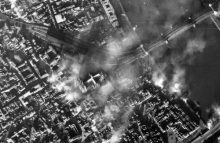NCAP and the German Bomb Disposal Industry
Aerial photography taken during the Second World War, now held by NCAP, is being used to provide bomb-disposal agencies with vital information on where hundreds of thousands of unexploded bombs remain buried in German soil.
During the Second World War, millions of tonnes of bombs were dropped by the Allies, and estimates are that between 10 and 15 per cent failed to explode. Today, many of them are still present underground or underwater and pose a significant risk. Around five thousand are rendered safe each year, and barely a day goes by without a live bomb being discovered somewhere in Germany. It costs each of the country’s 16 states around €10 million a year to dispose of them.
The analysis of aerial reconnaissance photographs held by NCAP is an essential process in locating unexploded ordnance - allowing specialists to excavate, make safe and then remove and destroy bombs that were dropped over 60 years ago. NCAP holds millions of pre-raid reconnaissance and post-raid damage assessment photographs taken by the RAF during the Second World War. NCAP also houses the sortie plots on which every photographic frame taken was marked in black ink, numbered and dated. The archive represents the legacy of a once top secret wartime photographic interpretation unit that was based at RAF Medmenham in Buckinghamshire – known as the Allied Central Interpretation Unit (ACIU). The NCAP team are now analysing the images to help German clients – from housing companies to motorway constructors – scope out the land where they plan to build, as part of a legally-required risk assessment process.
Only a small percentage of NCAPs millions of images have so far been catalogued and digitised – the photographs are held on thousands of canisters of film and over 14,000 boxes of microfilm. The long term conservation plan for NCAP includes further research and progressive digitisation of the photography for display online, as well as storing, preserving and interpreting the original photography for public accessibility.


